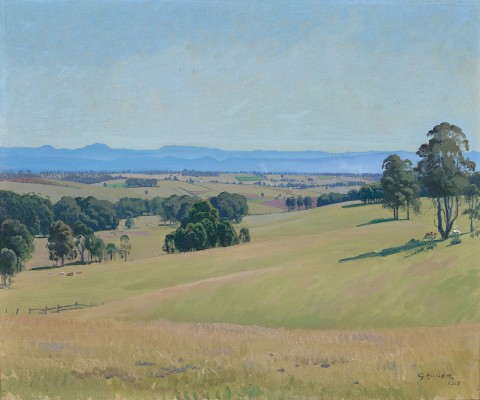WINDSOR LANDSCAPE, 1929
ELIOTH GRUNER
oil on canvas
51.0 x 61.0 cm
signed and dated lower right: GRUNER / 1929
inscribed with title on gallery label attached verso: Windsor Landscape
bears inscription on stretcher bar verso: WINTER LANDSCAPE
Macquarie Galleries, Sydney
Mr Norman Pope, acquired from the above in 1929
Mr and Mrs Saul Symonds, Sydney, by 1940
Commercial Banking Company, Sydney
The National Australia Bank Art Collection, acquired from the above in 1982 (label attached verso)
Society of Artists’ Annual Exhibition, Education Department’s Art Gallery, Sydney, 7 September – 4 October 1929, cat. 102
Loan Exhibition of the Works of Elioth Gruner, National Art Gallery of New South Wales, Sydney, 21 December 1932 – 21 February 1933, no. 62
Elioth Gruner Memorial Loan Exhibition, National Art Gallery of New South Wales, Sydney, 17 April – 31 May 1940, cat. 41 (label attached verso)
We are grateful to Steven Miller, Head of the Edmund and Joanna Capon Research Library and Archive, Art Gallery of New South Wales, for his assistance with this catalogue entry.
‘the old type of landscape… advances like a huge tide – washing its way into a thousand households, filling up our open spaces on living walls. It will always be in demand.’1
- Sydney Ure-Smith, 1926
With this bold statement, the publisher Sydney Ure-Smith stated a truth about Australian painting in the 1920s. However, he was also using this editorial in Art in Australia to praise the new paintings brought back from European journeys by Elioth Gruner and Roy de Maistre, and in so doing, signal his ongoing support for Sydney’s nascent modernist art world. Gruner’s reputation as one of this country’s most celebrated landscape artists has taken a shaking in London during an encounter with Sir William Orpen. Standing in front of his paintings at the Government-sponsored Exhibition of Works of Australian Artists in 1923, the elder British artist roundly criticised the Australian’s technique, unaware that the Exhibition Manager standing next to him was in fact Gruner himself. Embarrassed, Orpen tried to rectify the awkwardness by giving some technical and aesthetic advice which he hoped would be of benefit. To his credit, Gruner, an introverted but thoughtful man, considered the conversation deeply over the next months, particularly when viewing original paintings by Cézanne and others in France. On his return to Australia, he put his ideas into practice and by the end of the decade, when Windsor landscape, 1929, was painted, Gruner had ‘made a shift towards a more contemporary idiom, embracing colour like never before, and confirming his resolve to simplify his compositions with a greater control and clarity of form.’2
The attitudinal differences in these later landscapes can be seen clearly when compared with The White Road, Mt. Lofty, S.A., 1926 (lot 19). This earlier painting still adheres to Gruner’s pre-Europe palette and design but is energised in its paint strokes by the subsequent encounter with Cézanne. By comparison, Windsor Landscape has a quietude of benevolent order, emphasised through the artist’s mature technique. Gruner still retains the example set by Claude Lorrain of a foreground, middle ground and distance treated as three distinct steps, akin to stage sets, but instead of blending the edges in the traditional manner, Gruner flattens his lands into intersecting planes, blocks and colour shifts. There are multiple angles and directions in Windsor Landscape, from the outcrops of trees to the sharpened lines at the edges of paddocks, all preceded by the conversely gentle contours of the hills. Smoke from farm burn-offs emphasise the land’s human character, and the distant rise of the Blue Mountains are just that, a misty two-tone blue painted boldly and devoid of detail, yet still retaining an uncanny accuracy. Surmounting it all is the artist’s ‘lyrical outburst of delight in the beauty of light’s mysterious penetration from outer space. For Gruner’s skies have the fourth dimension of infinity. They go beyond the dome of the atmosphere.’3
In March 1929, Gruner was honoured with a special edition of Art in Australia, devoted to his career, and in January the next year, he was awarded his fourth Wynne Prize for Landscape Painting at the Art Gallery of New South Wales.
1. Ure Smith, S., ‘Editorial’, Art in Australia: a quarterly magazine, Sydney, 3rd series, no.17, September 1926, p. 5
2. Wilson, N., ‘Elioth Gruner: Australia’s laureate of landscape’, Art Gallery of New South Wales, Sydney, 11 May 2011, p. 6
3. Lindsay, N., ‘Foreword’, Elioth Gruner: twenty-four reproductions in colour from original oil paintings, Shepherd Press, Sydney, 1947, n.p.
ANDREW GAYNOR
